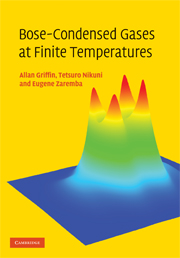Book contents
- Frontmatter
- Contents
- Preface
- 1 Overview and introduction
- 2 Condensate dynamics at T = 0
- 3 Coupled equations for the condensate and thermal cloud
- 4 Green's functions and self-energy approximations
- 5 The Beliaev and the time-dependent HFB approximations
- 6 Kadanoff–Baym derivation of the ZNG equations
- 7 Kinetic equation for Bogoliubov thermal excitations
- 8 Static thermal cloud approximation
- 9 Vortices and vortex lattices at finite temperatures
- 10 Dynamics at finite temperatures using the moment method
- 11 Numerical simulation of the ZNG equations
- 12 Simulation of collective modes at finite temperature
- 13 Landau damping in trapped Bose-condensed gases
- 14 Landau's theory of superfluidity
- 15 Two-fluid hydrodynamics in a dilute Bose gas
- 16 Variational formulation of the Landau two-fluid equations
- 17 The Landau–Khalatnikov two-fluid equations
- 18 Transport coefficients and relaxation times
- 19 General theory of damping of hydrodynamic modes
- Appendix A Monte Carlo calculation of collision rates
- Appendix B Evaluation of transport coefficients: technical details
- Appendix C Frequency-dependent transport coefficients
- Appendix D Derivation of hydrodynamic damping formula
- References
- Index
11 - Numerical simulation of the ZNG equations
Published online by Cambridge University Press: 06 October 2009
- Frontmatter
- Contents
- Preface
- 1 Overview and introduction
- 2 Condensate dynamics at T = 0
- 3 Coupled equations for the condensate and thermal cloud
- 4 Green's functions and self-energy approximations
- 5 The Beliaev and the time-dependent HFB approximations
- 6 Kadanoff–Baym derivation of the ZNG equations
- 7 Kinetic equation for Bogoliubov thermal excitations
- 8 Static thermal cloud approximation
- 9 Vortices and vortex lattices at finite temperatures
- 10 Dynamics at finite temperatures using the moment method
- 11 Numerical simulation of the ZNG equations
- 12 Simulation of collective modes at finite temperature
- 13 Landau damping in trapped Bose-condensed gases
- 14 Landau's theory of superfluidity
- 15 Two-fluid hydrodynamics in a dilute Bose gas
- 16 Variational formulation of the Landau two-fluid equations
- 17 The Landau–Khalatnikov two-fluid equations
- 18 Transport coefficients and relaxation times
- 19 General theory of damping of hydrodynamic modes
- Appendix A Monte Carlo calculation of collision rates
- Appendix B Evaluation of transport coefficients: technical details
- Appendix C Frequency-dependent transport coefficients
- Appendix D Derivation of hydrodynamic damping formula
- References
- Index
Summary
In this chapter we describe the numerical methods that can be used to solve the ZNG equations in the context of a dynamical simulation. These equations consist of a generalized GP equation (3.21) for the condensate and a Boltzmann equation (3.42) for the thermal component. The fact that the two equations are coupled makes their numerical solution more complex than when either is considered on its own. Indeed, the distinct quantum and classical aspects of the problem require specifically tailored numerical methods. Although most of these methods are well established and described elsewhere (Taha and Ablowitz, 1984; Sanz-Serna and Calvo, 1994), we provide in this chapter a detailed pedagogical discussion that will serve as a guide to those interested in carrying out such calculations for trapped Bose gases. This chapter is based on the papers of Jackson and Zaremba (2002a,b).
There are two main parts to the numerical problem. The first is developing a method for solving the time-dependent GP equation for an arbitrary three-dimensional geometry. This we take up in Section 11.1. Second, a method is needed for solving the Boltzmann equation that accounts for the dynamics of the thermal component. Here one must deal both with the Hamiltonian dynamics of the thermal atoms, as they move in the self-consistent mean field of the condensate and thermal cloud, and with the collisions that take place between the thermal atoms themselves (the C22 collisions) and between the thermal atoms and the condensate (the C12 collisions). The methods used to account for these two distinct collisional processes are taken up in Section 11.3. As we shall see, collisions play an important role and cannot be neglected even when the dynamical behaviour is dominated by mean-field interactions.
- Type
- Chapter
- Information
- Bose-Condensed Gases at Finite Temperatures , pp. 227 - 255Publisher: Cambridge University PressPrint publication year: 2009



